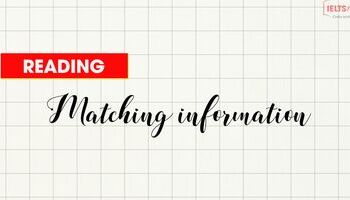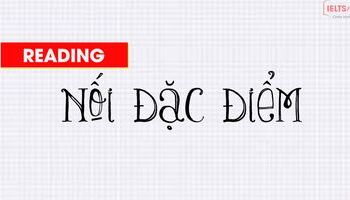Tương tự như Task 1, Task 2 có những từ vựng và cấu trúc thường sử dụng để mở bài, kết bài hay liên kết các ý trong bài logic và thú vị hơn. Hôm nay IELTS Fighter sẽ chia sẻ thêm về từ vựng, cấu trúc hay dùng cho Task 2 để cùng học nhé!
Nếu bạn chưa có hay biết rõ từ vựng quan trọng cho Task 1 thì xem Từ vựng và ngữ pháp quan trọng cho Task 1
I. TỪ VỰNG DÙNG CHO IELTS WRITING TASK 2
Từ vựng quan trọng cho Task 2 sẽ là tổng hợp những từ nối chủ yếu. Từ nối là các từ kết nối các đoạn văn với nhau, nó giúp người đọc nắm được ý của bài đọc tốt hơn và làm cho đoạn thêm “mượt mà” hơn khi đọc. Trong bài viết, bạn cần phải dùng từ nối giữa các đoạn để bảo đảm tính logic và chặt chẽ hơn.
Từ nối không chỉ giới hạn trong các từ như ‘as a result, in addition, while . . . , since . . . , etc.’, mà nó còn bao gồm các từ khóa được nhắc đi nhắc lại nhiều lần trong đoạn văn. Từ nối giữa các đoạn văn thường được đặt ở đầu đoạn tiếp theo của bài văn.
Từ nối là một nguyên liệu quan trọng việc hình thành câu và mở rộng câu. Ngoài ra, từ nối cũng là yếu tố đóng góp phần lớn vào yếu tố Coherence and Cohesion (Tính mạch lạc và liên kết) khi giám khảo đánh giá bài viết của bạn.
Từ nối thường rất đa dạng và chia thành các nhóm nghĩa khác nhau. Dưới đây là những nhóm từ hay sử dụng nhất trong bài viết IELTS task 2.
1. Từ nối chỉ trình tự
To begin with
First, second, next, then, before, after, finally
While, meanwhile, at the same time
Firstly, Secondly, etc.
In the first place, In the second place, etc.
Ví dụ: To begin with, doing part-time jobs can help students be financially independent.
First, you should figure out how much you can afford to pay for rent. Second, you should look at real estate ads to find apartments in your price range.
2. Từ nối mang tính bổ sung
In addition, Moreover, Furthermore, Additionally, Beside
Ví dụ:
Air pollution has negative effects on the environment. Additionally, it also affects our health.
Playing too much video games is a waste of time. Furthermore, it also causes some health problems.
3. Từ nối mang nghĩa đối lập
However, Yet, In/By contrast, Conversely, On the other hand, On the contrary, Otherwise, Nevertheless, Notwithstanding, In spite of this, By contrast, Whereas
Ví dụ
However, national and international policies will only succeed if individuals also change their lifestyles.
On the other hand, some sports matches may worsen the international relations
4. Từ nối mang nghĩa so sánh, so sánh ngang bằng
Likewise, Similarly, In the same way, In like manner...
Ví dụ
The effects of water pollution on the environment is adverse. Similarly, its impacts on our health are also terrible.
5. Từ nối mang nghĩa nguyên nhân, kết quả, mục đích
Therefore, Thus, Hence, Consequently, As a result, As a consequence, After all, Accordingly, Knowing this, With this in mind
Ví dụ
Nowadays, the youngsters spend a lot of time on social media. Consequently, the amount of time they spend on studying is much less.
Many people hunt wild animals for their own profits. As a result, a great number of these animals has been reduced dramatically.
6. Từ nối đưa ra ví dụ
For example, For instance, In particular, Indeed, Namely, Specifically, More specifically, To illustrate, In other words, In fact, That is, In brief
Ví dụ:
Wearing uniforms bring about many benefits. For example, the gap between the rich students and the poor ones will be limited.
People who spend 8 hours working in office per day should spend more time on exercises. For instance, they can have 5-minute exercises during each shift.
7. Từ nối dùng cho kết bài và tóm tắt
- As a result
- As has been noted
- As I have said
- As mentioned earlier
- In conclusion
- To conclude
- In brief, finally
- In other words
- In short
- In a/one word
- On the whole
- Therefore
- In summary
- To summarize
- To sum up
- In a nutshell
- All in all.
8. Từ nối mang tính chất thời gian
- Afterwards
- Soon
- Meanwhile
- In the meantime
- Next
- Then
- Later
- Eventually
- At the same time
- In the same instant
- Today
- Nowadays
- In the beginning
- To begin
- In time
- In future
- Finally
- Initially
- Subsequently
- Simultaneously.
Đọc đoạn văn mẫu sau và chú ý tới các từ nối (transition words) được sử dụng. Những từ nối là những từ được tô sáng (highlighted) trong bài viết để giúp các bạn dễ nhận biết hơn.
Some people think that museums should be enjoyable places to entertain people, while others believe that the purpose of museums is to educate.
Discuss both views and give you own opinion.
Sample Answer
People have different views about the role and function of museums. In my opinion, museums can and should be both entertaining and educational.
On the one hand, it can be argued that the main role of a museum is to entertain. Museums are tourist attractions, and their aim is to exhibit a collection of interesting objects that many people want to see. The average visitor may become bored if he or she has to read or listen to too much educational content, so museums often put more of an emphasis on enjoyment rather than learning. This type of museums is designed to be visually spectacular, and it may have interactive activities or even games as part of its exhibitions.
On the other hand, some people argue that museums should focus on education. The aim of any exhibition should be to teach visitors something that they did not previously know. Usually this means that the history behind the museum’s exhibits needs to be explained, and this can be done in various ways. Some museums employ professional guides to talk to their visitors, while other museums offer headsets so that visitors can listen to detailed commentary about the exhibition. This way, museums can play an important role in teaching people about history, culture, science and many other aspects of life.
In conclusion, it seems to me that a good museum should be able to offer an interesting, enjoyable and educational experience so that people can both have fun and learn something at the same time.
(253 Words)
9. Các từ nối cao cấp hơn
Từ nối không chỉ là những từ như ‘firstly’, ‘furthermore’ và ‘moreover’. Có nhiều cách cao siêu hơn để kết nối các ý của đoạn văn với nhau mà bạn có thể sử dụng trong bài thi Writing:
- Dùng đại từ ‘this’ hoặc ‘these’ để nói về ý tưởng đã nhắc đến trước đấy.
- Dùng đại từ như ‘it’ và ‘they’ để nhắc lại danh từ ‘nouns’ bạn đã nhắc đến trước đấy.
- Nhắc lại các từ khóa quan trọng trong đoạn văn một cách khéo léo.
- Nhắc lại ý chính bằng các cách khác nhau.
- Phát triển ý tưởng theo cách từ bao quát đến cụ thể (from 'general' to 'specific').
Bạn sẽ nhận ra rằng các cách nối này sẽ giúp bài văn tự nhiên và trôi chảy, và câu văn linh hoạt. Ví dụ sau sẽ giúp bạn hình dung rõ hơn về 5 cách sau nhé:
Some art projects definitely require help from the state. In the UK, there are many works of art in public spaces, such as streets or squares in city centers. In Liverpool, for example, there are several new statues and sculptures in the docks area of the city, which has been redeveloped recently. These artworks represent culture, heritage and history. They serve to educate people about the city, and act as landmarks or talking points for visitors and tourists. Governments and local councils should pay creative artists to produce this kind of art, because without their funding our cities would be much less interesting and attractive.
Color key:
- These, this = nhắc lại ý trước đó
- Which, they = đại từ nhắc lại danh từ và cụm danh từ trước đó (e.g. they = artworks)
- Art = từ khóa được nhắc lại vì nó là chủ đề chính của bài khóa
- Art projects = ý chính được nhắc lại bằng cách khác, thể hiện sư linh hoạt và đa dạng về từ vựng
- The state, the UK = từ bao quát đến cụ thể
Dùng firstly, secondly and finally để kết nối ý tưởng
Có nhiều bạn sẽ cho rằng việc dùng "firstly, secondly, finally" quá đơn giản và dễ gây nhàm chán cho bài viết. Tuy nhiên, tận dụng các từ đơn giản này sẽ giúp bạn tiết kiệm thời gian để viết các ý chính, lựa chọn từ vựng, cụm từ (collocations) và ví dụ (examples), đây mới chính là những điều giám khảo sẽ đánh giá bài viết của bạn. Bạn vẫn có thể được 9.0 cho Writing ngay cả khi những từ "firstly, secondly, finally" xuất hiện, miễn là ý tưởng của bạn được dẫn ra chặt chẽ và mạch lạc.
Tuy nhiên, vẫn có các từ thay thế cho "firstly, secondly, finally" mà các bạn có thể dùng như:
- The main reason why I believe... is... / Another argument is... / Also,...
- One problem is that... / Furthermore,... / Another drawback is that...
- From a business perspective,... / In terms of education,... / From a social point of view,...
Các bạn hãy đọc các ví dụ mẫu sau để hiểu hơn về cách dùng những từ này một cách hiệu quả nhé:
Ví dụ
Nowadays the way many people interact with each other has changed because of technology.
In what ways has technology affected the types of relationships that people make? Has this been a positive or negative development?
It is true that new technologies have had an influence on communication between people. Technology has affected relationships in various ways, and in my opinion there are both positive and negative effects.
Technology has had an impact on relationships in business, education and social life. Firstly, telephones and the Internet allow business people in different countries to interact without ever meeting each other.
Secondly, services like Skype create new possibilities for relationships between students and teachers. For example, a student can now take video lessons with a teacher in a different city or country. Finally, many people use social networks, like Facebook, to make new friends and find people who share common interests, and they interact through their computers rather than face to face.
On the one hand, these developments can be extremely positive. Cooperation between people in different countries was much more difficult when communication was limited to written letters or telegrams. Nowadays, interactions by email, phone or video are almost as good as face-to-face meetings, and many of us benefit from these interactions, either in work or social contexts. On the other hand, the availability of new communication technologies can also have the result of isolating people and discouraging real interaction. For example, many young people choose to make friends online rather than mixing with their peers in the real world, and these ‘virtual’ relationships are a poor substitute for real friendships.
In conclusion, technology has certainly revolutionized communication between people, but not all of the outcomes of this revolution have been positive.
(257 words)
Bài tập:
Ex 13: Sử dụng từ nối thích hợp để viết lại các câu sau:
a. Many websites contain information that isn’t suitable for children. People should control how their children use the Internet. (Therefore / For instance / Nevertheless)
b. It is easy to stay informed about the current events. The Internet provides us with instant access to news. (Likewise / For instance / Accordingly)
c. There are several advantages to live in this neighborhood. It is close to two bus routes. (For example / On the other hand / While)
d. City life is stressful because of the crowds and noise. High levels of crime make cities really dangerous. (In contrast / Accordingly / Moreover)
e. Many people find small towns boring. Others enjoy a small town’s slow pace of life. (For example / Consequently / However)
f. Gas emission and exhaust fumes from vehicles lead to global warming. This negatively influences the planet in the future. (Indeed / In contrast / Meanwhile)
g. Playing sport is good for health. It involves a lot of physical activities. (since / because of / but)
h. A wealthy city attracts large population inflows. This may cause pressure on existing infrastructure and security. (Nevertheless / Consequently / Likewise)
i. Some people feel that it is cruel to keep the animals in the zoos. Others believe that zoos provides important opportunities for researching and educating. (Besides / On the other hand / Specifically)
II. CẤU TRÚC CÂU CHO WRITING TASK 2
Cấu trúc câu cho phần mở bài
1. Many/some people claim/believe that...
Nhiều / một số người tuyên bố/ tin rằng ...
2. There is no denying that...
Không thể phủ nhận rằng...
3. It goes without saying that...
Không cần phải nói rằng ...
4. These days.../ Nowadays.../ In this day and age...
Những ngày này ... / Ngày nay ... / Trong thời đại ngày nay ...
5. It is often said that...
Người ta thường nói rằng ...
6. It is universally accepted that...
Mọi người đều chấp nhận rằng ...
7. People are divided in their opinion regarding...
Mọi người chia rẽ theo ý kiến của họ về ...
8. We live in an age when many of us are...
Chúng ta đang sống trong thời đại mà nhiều người trong chúng ta ...
9..... is one of the most important issues...
.... là một trong những vấn đề quan trọng nhất ...
10. Whether .... or .... is a controversial issue...
Cho dù .... hay .... là một vấn đề gây tranh cãi ...
Từ và cụm từ hữu ích để kết thúc phần giới thiệu
1. Let us examine both views before reaching a concrete decision.
Hãy để chúng tôi kiểm tra cả hai quan điểm trước khi đi đến một quyết định cụ thể.
2. The following paragraphs discuss whether ...... or ...... and reach a reasonable conclusion.
Các đoạn sau thảo luận về việc ...... hay ...... và đưa ra kết luận hợp lý.
3. I oppose the view and my reasons will be explained in the following paragraphs.
Tôi phản đối quan điểm và lý do của tôi sẽ được giải thích trong các đoạn sau.
4. My two cents go for...
Hai xu của tôi dành cho ...
5. I personally believe that...
Cá nhân tôi tin rằng ...
6. The following essay takes a look at both sides of the argument.
Bài tiểu luận sau đây sẽ xem xét cả hai mặt của lập luận.
7. I will support this view with arguments in the following paragraphs.
Tôi sẽ hỗ trợ quan điểm này với các đối số trong các đoạn sau.
8. However, I strongly believe that...
Tuy nhiên, tôi tin tưởng mạnh mẽ rằng ...
9. Thus the advantages far outweigh the disadvantages...
Do đó, những lợi thế vượt xa những nhược điểm ...
10. I wholeheartedly believe that this trend should be changed.
Tôi hoàn toàn tin tưởng rằng xu hướng này nên được thay đổi.
Cách viết kết bài trong IELTS Writing Task 2
IELTS Writing Task 2 chỉ yêu cầu 1 kết bài ngắn gọn và đủ ý bởi nội dung ở phần thân bài mới là điều được chú ý cao của toàn bài viết. Nếu kết bài của bạn ngắn và đơn giản, đừng lo lắng gì cả, điều đó hoàn toàn được chấp nhận. Thậm chí bạn cũng không cần thiết nghĩ ra những ý tưởng mới mẻ, đột phá cho kết bài; bạn chỉ cần paraphrase mở bài hoặc tóm tắt lại ý kiến lựa chọn của bạn mà thôi. Quan trọng là không đưa thêm lí do, không đưa thêm ý kiến mới, và không đưa ra các thông tin mới chưa được dẫn ra trong thân bài vào kết bài.
Các bạn hãy tham khảo các kết bài sau nhé:
1. Dạng câu hỏi ‘To what extent …’ (Opinion)
For the reasons mentioned above, I believe that... (+ repeat your opinion).
2. Dạng câu hỏi ‘Discuss both views and …’ (Discussion + Opinion)
In conclusion, there are convincing arguments both for and against... (paraphrased topic), but I believe that... (if the question asks for your opinion).
3. Dạng câu hỏi ‘Advantages and Disadvantages’ (Do the … outweigh the …?)
In conclusion, I would argue that the benefits of... (paraphrased topic) outweigh the drawbacks.
4. Dạng câu hỏi ‘Cause/Effect and Solutions’ (Problem and Solution)
In conclusion, it is clear that there are various reasons for... (paraphrased topic), and steps need to be taken to tackle this problem.
III. VÍ DỤ MỞ - KẾT BÀI MẪU THEO DẠNG BÀI
Ví dụ #1: Dạng đề ‘To what extent …’
The older generations tend to have very traditional ideas about how people should live, think and behave. However, some people believe that these ideas are not helpful in preparing younger generations for modern life.
To what extent do you agree or disagree with this view?
Mở bài mẫu:
It is true that many older people believe in traditional values that often seem incompatible with the needs of younger people. While I agree that some traditional ideas are outdated, I believe that others are still useful and should not be forgotten. (42 words)
Kết bài mẫu:
In conclusion, although the views of older people may sometimes seem unhelpful in today’s world, we should not dismiss all traditional ideas as irrelevant. (24 words)
Ví dụ #2: Dạng đề ‘Discuss both views and …’
Some people think that strict punishments for driving offences are the key to reducing traffic accidents. Others, however, believe that other measures would be more effective in improving road safety.
Discuss both these views and give your own opinion.
Mở bài mẫu:
People have differing views with regard to the question of how to make our roads safer. In my view, both punishments and a range of other measures can be used together to promote better driving habits.
Kết bài mẫu:
In conclusion, while punishments can help to prevent bad driving, I believe that other road safety measures should also be introduced.
Ví dụ #3: Dạng bài ‘Advantages and Disadvantages’
Modern societies need specialists in certain fields, but not others. Some people, therefore, think that governments should pay university fees for students who study subjects that are needed by society. Those who choose to study less relevant subjects should not receive the government funding.
Would the advantages of such an educational policy outweigh the disadvantages?
Mở bài mẫu:
In every country, there are fashions among students about which subjects are the best to the study at university. Sometimes the popularity of a subject is determined by how much money a graduate could subsequently earn in that field. Or subjects that are perceived as relatively ‘easy’ may also become popular, in spite of later difficulties of finding appropriate employment. It is up to governments to give incentives to students to choose subjects that match the needs of their society.
Kết bài mẫu:
In conclusion, I think there are many other incentives for students that could be considered, such as making courses more interesting to take, or the job rewards greater after graduation. The education policy proposed above, however, would certainly have more long-term disadvantages than benefits for society.
Ví dụ #4: Dạng bài ‘Cause/Effect and Solutions’
In some countries the average weight of people is increasing and their levels of health and fitness are decreasing.What do you think are the causes of these problems and what measures could be taken to solve them?
Mở bài mẫu:
Nowadays, obesity has become one of the outstanding problems in some countries especially in developed and developing ones in addition to the fact that the majority of people do not have healthy body.
Kết bài mẫu:
To conclude, I personally believe that the more we eat nutrition foods or do regular exercises, the healthier body we have as well as a healthier mindset.
Ví dụ #5: Dạng bài ‘Two-part Question’
Many people prefer to watch foreign films rather than locally produced films.
Why could this be?
Should governments give more financial support to local film industries?
Mở bài mẫu:
It is true that foreign films are more popular in many countries than domestically produced films. There could be several reasons why this is the case, and I believe that governments should promote local film- making by subsidising the industry.
Kết bài mẫu:
In conclusion, I believe that increased financial support could help to raise the quality of locally made films and allow them to compete with the foreign productions that currently dominate the market.
Ví dụ #6: Dạng bài ‘Two-part Question’
These days more fathers stay at home and take care of their children while mothers go out to work.
What could be the reasons for this?
Do you think it is a positive or a negative development?
Mở bài mẫu:
It is true that men are increasingly likely to take on the role of househusband, while more women than ever are the breadwinners in their families. There could be several reasons for this, and I consider it to be a very positive trend.
Kết bài mẫu:
In conclusion, the changing roles of men and women in the family are a result of wider changes in society, and I believe that these developments are desirable.
Dùng mệnh đề ‘while’ cho mở bài và kết bài
Thông thường, chúng ta hay mở đầu bằng câu "It is true that", sau đó, chúng ta sử dụng mệnh đề “while” để đưa ra ý kiến về 2 mặt của vấn đề, gói gọn trong 1 câu
Mở bài dùng 'while'
Bạn có thể đi theo cấu trúc sau đây:
While I accept ( … argument A), I favor (… argument B) Ví dụ tham khảo:
Early technological developments helped ordinary people and changed their lives more than recent developments. To what extent do you agree or disagree?
Mở bài mẫu:
Technological progress has taken place throughout the course of human history. While early technologies certainly changed the lives of normal people, I believe that recent breakthroughs have had an even greater impact.
Kết bài dùng 'while'
Có thể các bạn đều biết là chúng ta thường có xu hướng dùng "while" trong đoạn mở đầu. Ngoài ra có thể dùng câu "while" cho kết bài. Hãy xem ví dụ sau:
Some people think that strict punishments for driving offences are the key to reducing traffic accidents. Others, however, believe that other measures would be more effective in improving road safety. Discuss both these views and give your own opinion.
Kết bài mẫu:
In conclusion, while punishments can help to prevent bad driving, I believe that other road safety measures should also be introduced.
Bạn nên tránh sử dụng 'Tóm lại' (In a nutshell) vì nó không chính thức, mang tính trang trọng mà thay vào đó nên sử dụng 'Trong kết luận / để kết luận' (In conclusion/ to conclude).
Trên đây là tổng hợp từ nối, cụm từ, cấu trúc câu hay dùng cho Writing Tasks 2,các bạn tham khảo ứng dụng nhé. Để học tốt hơn, bạn cần đọc thêm bài viết sau:
Hướng dẫn cách viết Task 2 theo từng dạng bài
Hướng dẫn tự học IELTS Writing target 7.0
Đáp án:
a. Many websites contain information that isn’t suitable for children. Therefore, people should control how their children use the Internet.
b. It is easy to stay informed about the current events. For instance, the Internet provides us with instant access to news.
c. There are several advantages to live in this neighborhood. For example, it is close to two bus routes.
d. City life is stressful because of the crowds and noise. Moreover, high levels of crime make cities really dangerous
e. Many people find small towns boring. However, others enjoy a small town’s slow pace of life.
f. Gas emission and exhaust fumes from vehicles lead to global warming. Indeed, this negatively influences the planet in the future.
g. Playing sport is good for health involves a lot of physical activities since it involves a lot of physical activities.
h. A wealthy city attracts large population inflows. Nethertheless, this may cause pressure on existing infrastructure and security.
i. Some people feel that it is cruel to keep the animals in the zoos. On the other hand, others believe that zoos provides important opportunities for researching and educating.
Chúc các bạn học tập tốt và còn gì thắc mắc, hãy cmt để được giải đáp nhé!
Đặc biệt là ngay trong tháng này thì IELTS Fighter hiện đang có chương trình ưu đãi học phí siêu hấp dẫn cho các bạn học viên mới, đừng bỏ qua nhé:





